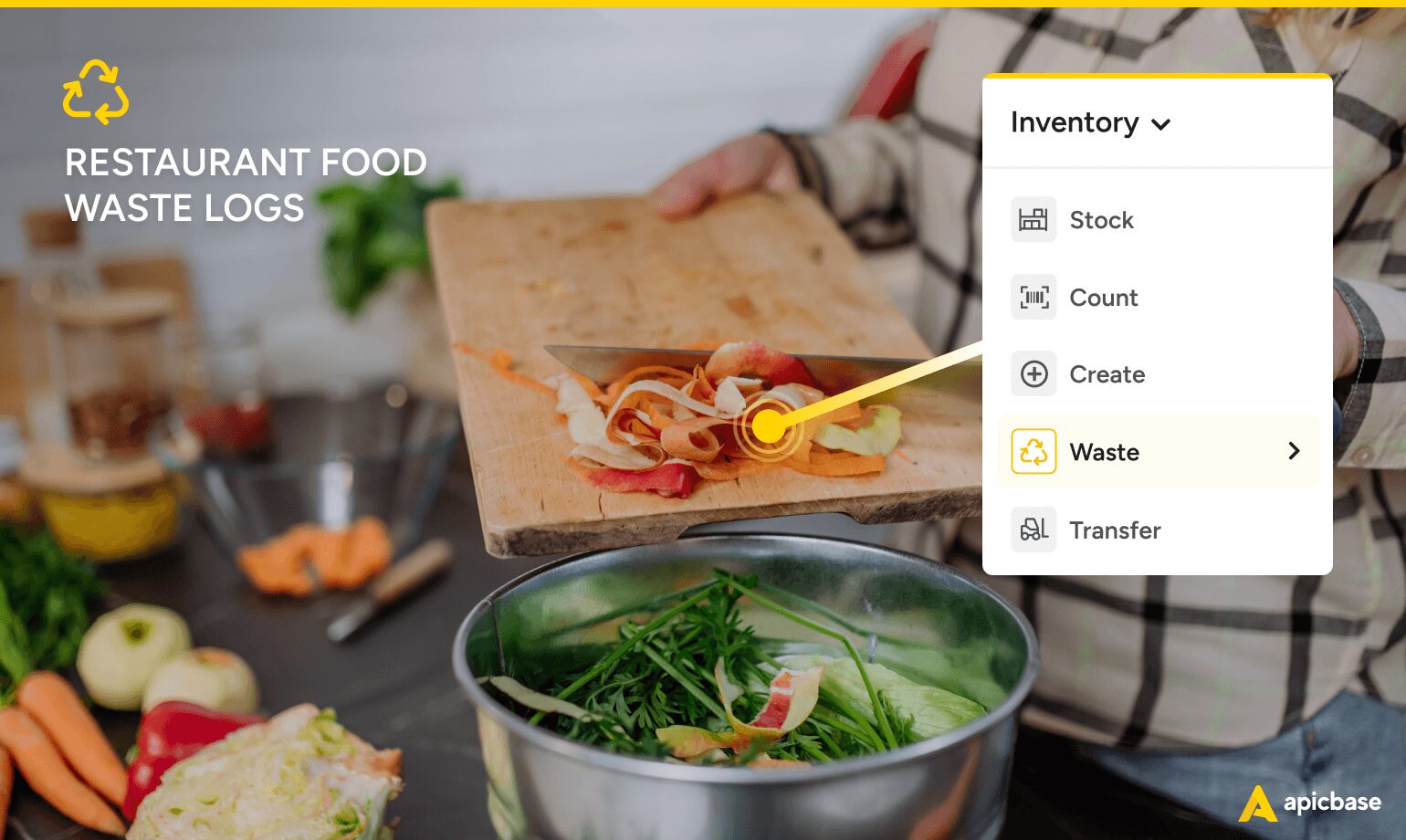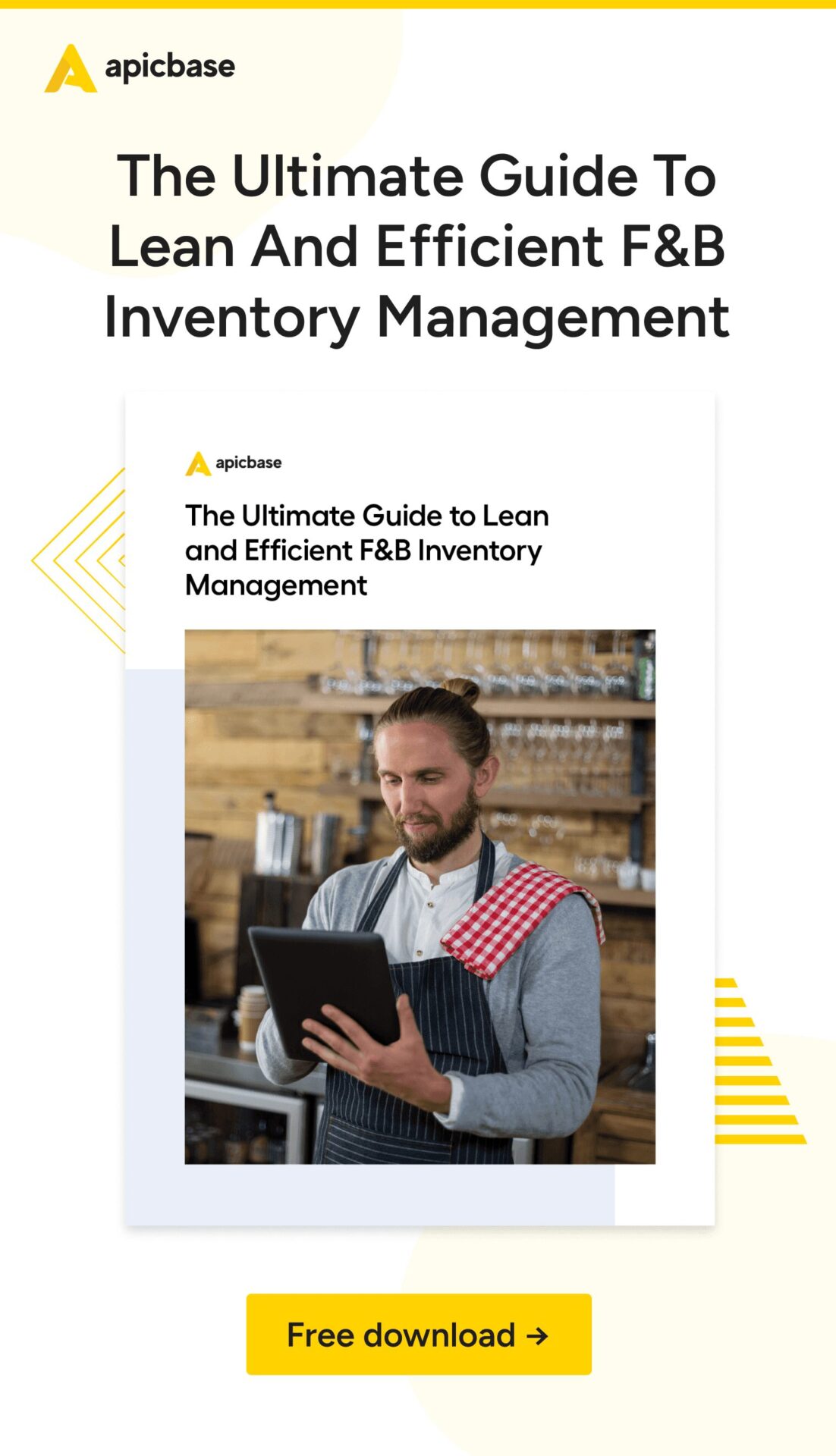Food waste is as bad for the environment as it is for your profits. Every scrap of food that goes in the bin represents a missed opportunity to make money. And the amount of food wasted in the restaurant industry is also a disaster for the planet.
Franco Prontera of Too Good To Go revealed in a recent interview with Apicbase CEO Carl Jacobs that “more than one-third, close to 40%, actually, of all the food that is produced worldwide ends up in the bin. That actually comes to around 2.5 billion tons of food every year.”
But restaurants have an opportunity to make a change for the planet and their profits.
In the same interview, Franco points out that 14% of the food that enters a commercial kitchen never reaches the customer. Eurostat determined that restaurants and food services account for 9% of food waste in EU. That leaves lots of room for improvement. A few small changes can have a massive impact and implementing a restaurant waste log is the first step.
Apicbase is a comprehensive restaurant management platform that not only makes operations more efficient but has specific tools and features to reduce food waste, thereby increasing profitability.
In this article, we explore restaurant food waste logs, examining their benefits, implementation, and best practices for maintenance.
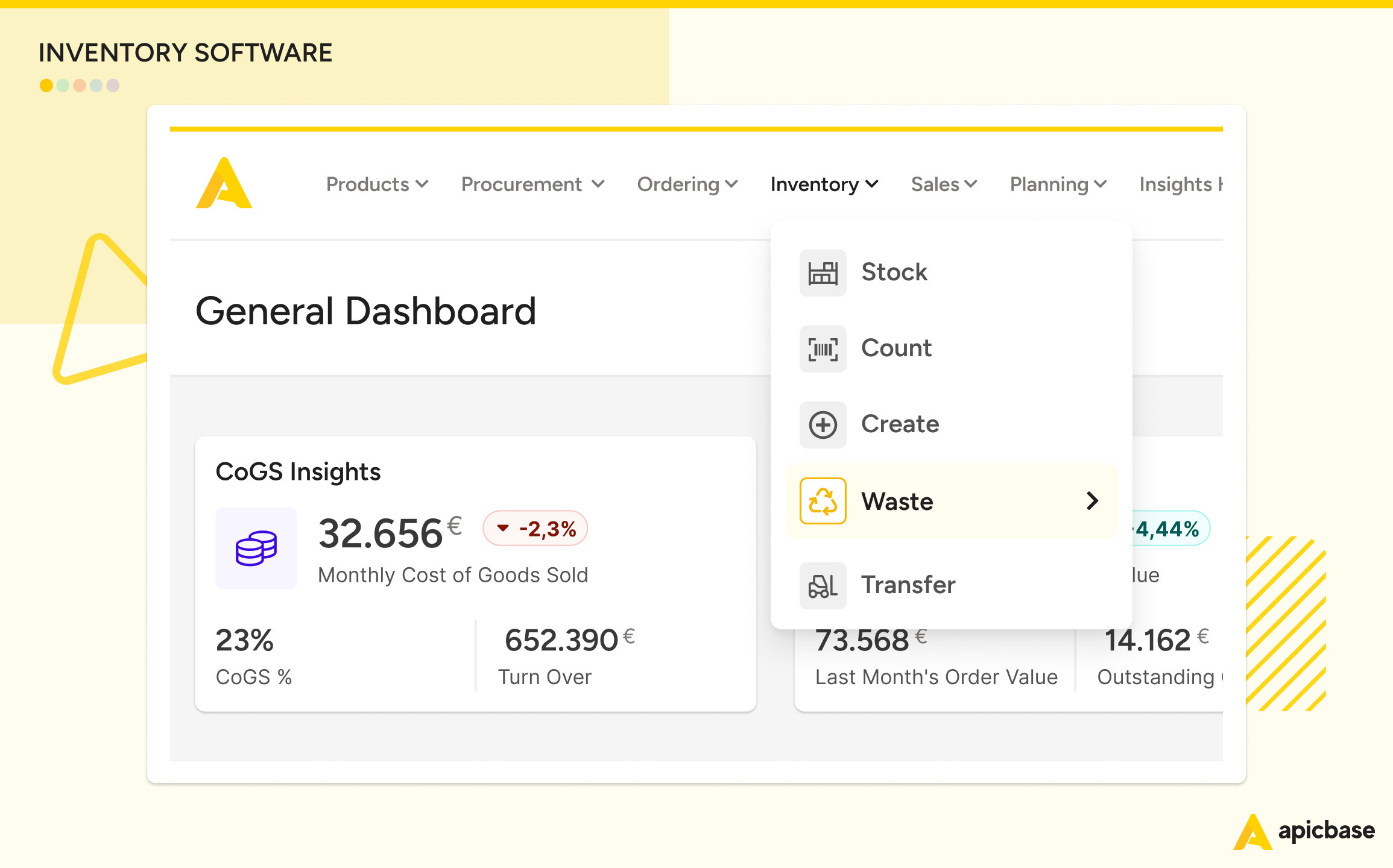
What is a restaurant waste log?
A restaurant food waste log is a tool used by restaurants to track and record the amount and types of food being wasted. This log helps identify patterns and causes of food waste, allowing you to implement strategies to reduce waste, improve efficiency, and reduce food costs.

Get the Ultimate Guide to Lean and Efficient Inventory Management for Multi-unit Restaurants
A step-by-step guide for hospitality professionals to manage their Inventory.
Key benefits of using a restaurant waste log
The purpose of a restaurant waste log is to measure the quantity and types of waste. This data helps identify the causes of food waste and develop solutions to minimise it. This approach offers a range of benefits for restaurants that extend beyond financial gains.
Save money through efficient resource use
Once you find out the causes of food waste, you can reduce the amount of purchased ingredients that end up in the bin.
Every bit of food that isn’t wasted directly affects the amount of food you need to purchase and reduces food costs. A study by environmental action group Champions 12.3 concluded that, on average, restaurants save €7 for every €1 invested in reducing food waste in their kitchens. This gives food waste reduction strategies an ROI of 700%.
Therefore, the more effectively you invest in tackling food waste, the more money you will save on your food bills. This means bigger profits without even having to produce more food or serve more guests. The gains come 100% from optimising internal processes, not from additional turnover.
Identify patterns and trends in food waste
Logging waste is crucial in identifying and correcting over-ordering, mishandling, and spoilage. By systematically recording waste data, restaurants can pinpoint inefficiencies in their procurement and inventory handling processes.
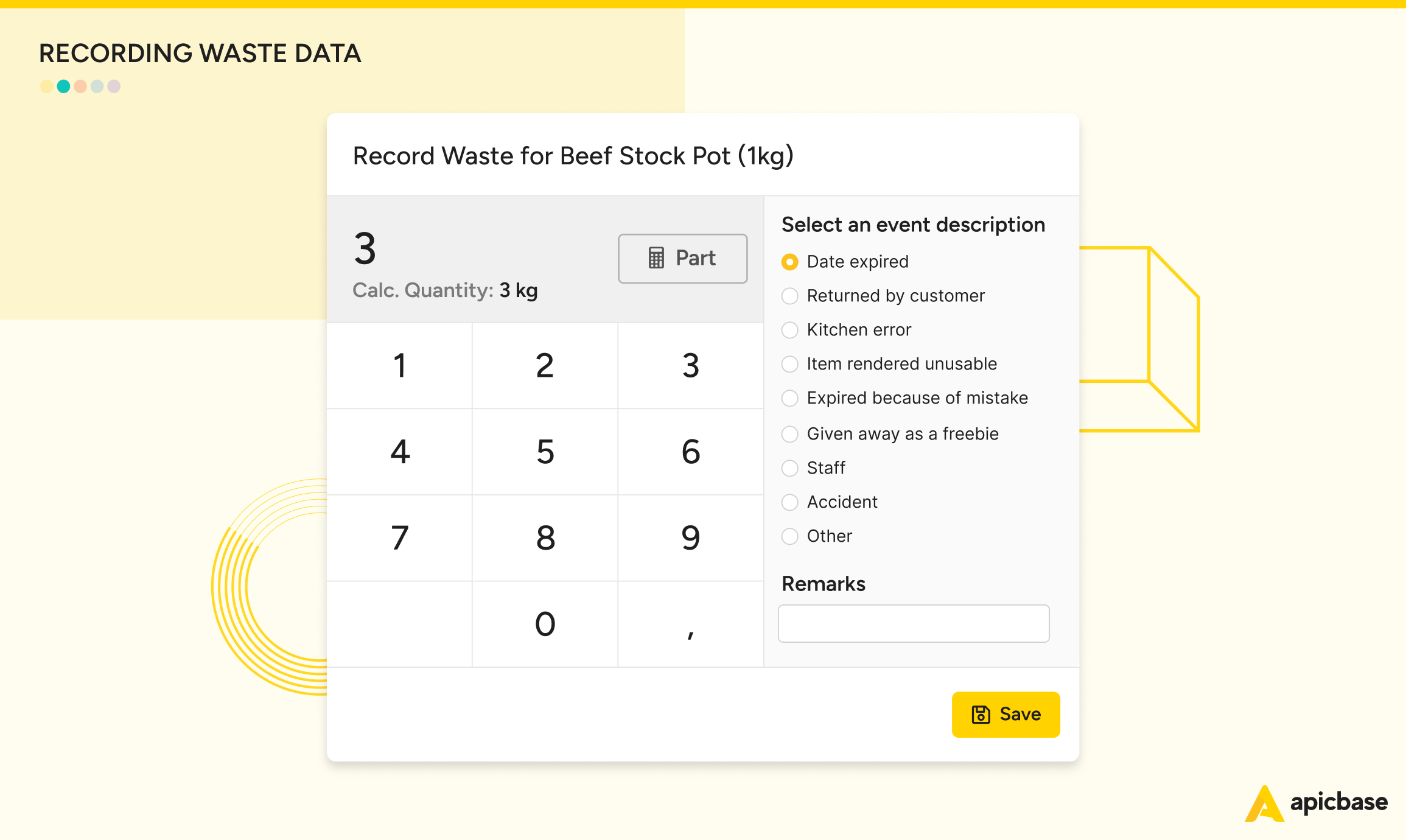
Detailed records of the total wasted value, waste percentage of COGS (Cost of Goods Sold), and waste by outlet tell you exactly where and why waste is occurring.
Apicbase’s procurement management dashboard breaks down waste by category and highlights the top 15 wasted ingredients by value. This allows managers to identify patterns and address specific issues, such as repeated over-ordering of certain items or improper storage techniques that lead to spoilage.
Apicbase’s integration with restaurant POS systems gives you a better understanding of the correlation between sales patterns and waste events. For example, if the data reveals that certain ingredients are frequently wasted after a particular dish is prepared, this might indicate a need to adjust portion sizes or improve cooking techniques.
Using these insights, you can refine your purchasing strategies and order only what you need – reducing food costs and boosting profitability.
Improve sustainability practices
Food waste has a significant environmental impact. A report by the Food and Agriculture Organisation of the United Nations found that food loss and waste contribute 8-10% of global greenhouse gas emissions.
This not only worsens climate change but also harms agricultural productivity. Unpredictable weather patterns and degraded land quality can reduce both crop yields and nutritional value.
Additionally, wasted resources disrupt supply chains, further straining the global food system. This adds extra pressure to the global food system, leading to shortages and higher prices. By reducing waste, we can improve the efficiency of supply chains and help ensure a more reliable food supply for everyone.
Reducing food waste is essential for improving sustainability within the restaurant industry. By minimising waste, you can lower your restaurant’s carbon footprint, conserve resources, and contribute to a more sustainable food system.
Waste logs also play a crucial role in the mandatory Environmental, Social, and Governance (ESG) reporting for large companies. ESG regulations require businesses to disclose their environmental impact, including waste management practices. By integrating waste reduction into ESG reporting, restaurants ensure compliance with regulations while also enhancing their reputation and appeal to eco-conscious consumers.
Regarding the Corporate Sustainability Reporting Directive (CSRD), it is worth noting that Apicbase offers both food waste and carbon footprint reports to help foodservice companies comply with sustainability reporting regulations.
Enhance staff awareness and accountability
Involving staff in waste logging is a powerful strategy to foster a culture of mindfulness and responsibility within your restaurant. When staff members are actively engaged in tracking and recording food waste, they become more aware of the impact of their actions on both the environment and the business’s bottom line.
This heightened awareness encourages employees to be more mindful of portion sizes, food handling, and storage practices, ultimately leading to a further reduction in waste. Making waste logging a routine part of their duties then encourages staff members to develop a sense of accountability for the food they handle.
How to implement a restaurant waste log in 6 steps
A food waste log is useless unless the information gathered is accurate and reliable. To ensure staff are logging waste correctly, you need to put in place a solid system and promote waste logging best practices.
Here are six steps to implement your food waste log the right way.
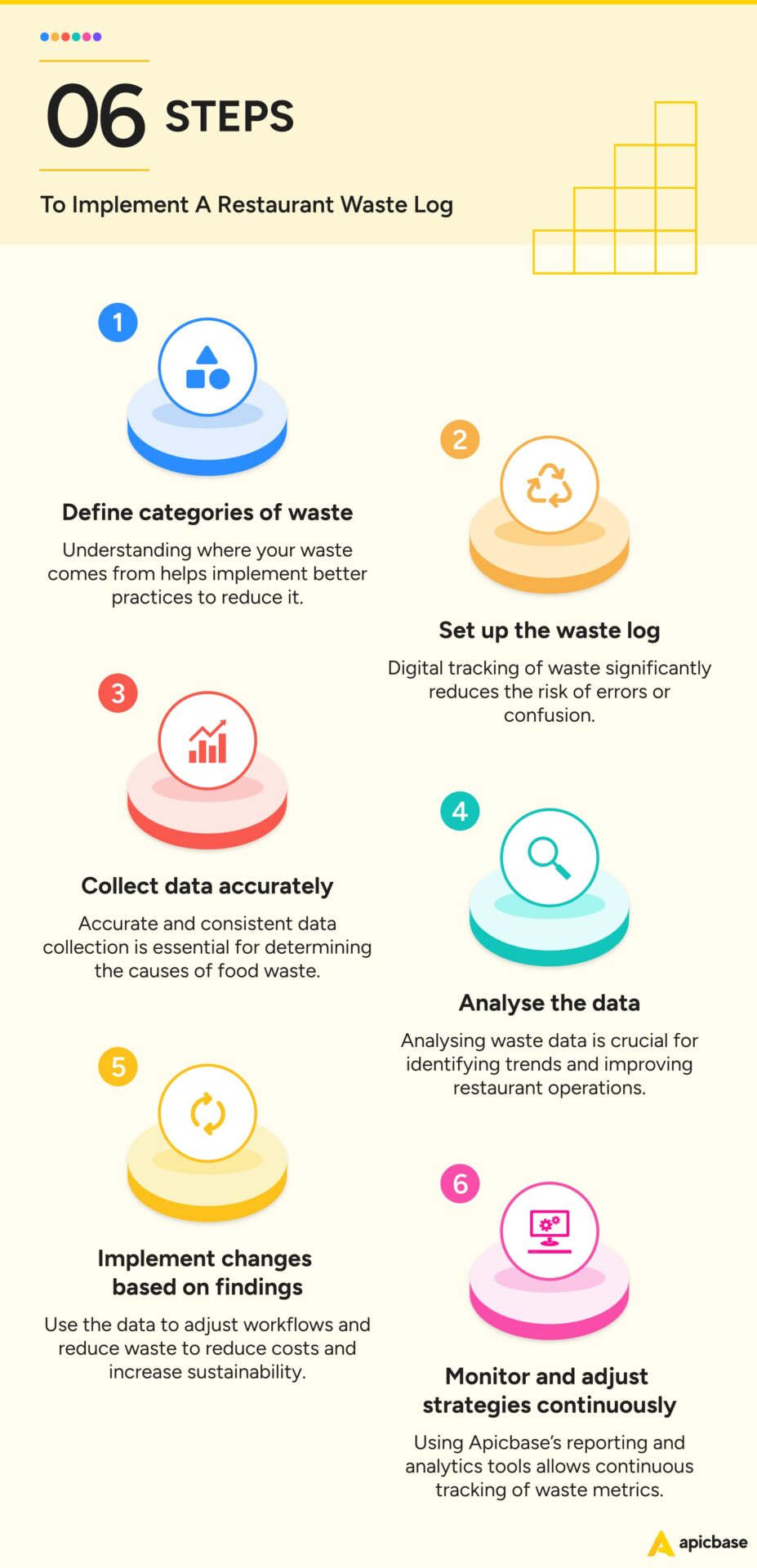
1. Define categories of waste
Firstly, define your categories of waste. This is crucial for determining the sources and causes of food waste. Understanding where your waste comes from helps implement better practices to reduce it.
Common categories include:
- Spoilage: Ingredients that are unusable due to expiration or poor storage.
- Prep Waste: Offcuts and trimmings, aka leftovers, from food preparation, such as vegetable trimmings and the fat, skin, and bones from fish and meat.
- Overproduction: Prepared food that isn’t sold by its optimal usage time.
- Plate Waste: Food that returns to the kitchen on customers’ plates.
- Accidental Waste: Food lost due to breakage or being dropped before reaching the customer.
2. Set up the waste log

Here are the data points to include in your waste log:
- Date and Time – when the waste was recorded
- Type of Food – specific items that are being wasted, for example, vegetables, meat, and dairy
- Quantity – The amount of food wasted, usually measured in weight or volume.
- Reason for Waste – why the food was wasted, for example, spoilage, over-preparation, or plate waste
- Staff Member – the person who recorded the waste for accountability
- Notes – additional comments or observations to aid the discovery process
Manually logging waste on a sheet of paper is a simple method, but it can be tedious and time-consuming. Managers will have to collate the information manually and store all the waste log sheets. Different employees may log waste in different ways, leading to inconsistent categories and data that have to be cleaned up manually.
Tracking waste digitally allows staff to quickly log waste into the correct categories, reducing the chance of errors or confusion. Apicbase guides staff through the process of recording food waste, including the category, amount, and reasons for the waste. Apicbase also integrates food waste data into its inventory management software, enabling you to combine it with inventory and sales data for real-time insights.
3. Collect data accurately
Accurate and consistent data collection is essential for determining the causes of food waste. It’s especially important to collect accurate and consistent data when recording waste across multiple kitchens, restaurants, and locations.
Here are some tips to ensure the accuracy and consistency of data collection:
- Standardise Processes – Establish clear procedures for logging waste, including specific guidelines on how to measure quantities, categorise waste, and record reasons for disposal.
- Train Staff – Regularly train all employees on the importance of waste logging and the proper techniques for accurate recording. Well-informed staff are more likely to adhere to procedures and contribute to reliable data collection.
- Use Technology – Implement an inventory management system that automates data collection, reducing manual entry errors. Automated systems can provide real-time data and analytics, improving overall accuracy.
- Simplify Data Entry – Make the logging process as straightforward as possible. Simplified forms or digital interfaces reduce errors and encourage consistent data logging.
- Provide Feedback – Regularly review waste data with staff and provide feedback. Recognising accurate logging efforts and discussing areas for improvement reinforces the importance of precise data collection.
The Top 5 KPIs to Track
To drive down costs and improve waste management, restaurants should focus on tracking the following key performance indicators:
- Total Wasted Value – The monetary value of all food waste.
- Waste % of COGS – The percentage of waste relative to the Cost of Goods Sold tells you how waste affects profitability.
- Waste by Outlet – Waste data for each location, allowing comparison and identification of the most wasteful outlets.
- Waste Category % of Total Wasted Value in Outlet – The breakdown of waste by category within each outlet to pinpoint specific problem areas.
- Waste Over Time – Trends in waste over different periods, helping identify patterns and measure the effectiveness of waste reduction efforts.
Monitoring these KPIs through an automated inventory management system, like Apicbase, provides restaurants with the insights needed to reduce waste and improve overall operational efficiency.
4. Analyse the data
Effective analysis of waste data is crucial for identifying trends and areas for improvement in restaurant operations. By systematically analysing data, restaurants can uncover patterns that inform strategic decisions aimed at reducing waste, lowering costs, and enhancing efficiency.
Here are some of the methods you can use for waste reduction data analysis:
- Time-Based Trends—Analyse waste data over various periods (daily, weekly, monthly, and seasonally) to identify patterns. For example, increased waste on weekends or during specific seasons can highlight issues with demand forecasting or menu planning.
- Category Trends—Examine which categories of food, such as meat, dairy, or dry goods, are consistently wasted. This helps identify specific types of ingredients that are prone to over-purchasing or mishandling.
- Reasons for Waste—Break down waste data by the reasons recorded (spoilage, over-preparation, customer returns). Identifying the predominant causes of waste allows targeted interventions to address these issues.
5. Implement changes based on findings
Once waste data has been analysed, it’s time to implement impactful changes. Here are some examples of changes you might make:
- Adjust Order Quantities – Use accurate demand forecasting to adjust order quantities, reducing the risk of over-ordering and spoilage.
- Retraining Staff – Train staff on best practices for food handling, storage, and portion control to minimise waste. Raising awareness about the impact of food waste can also foster a culture of responsibility and efficiency.
- Menu Engineering – Optimise your menu by removing or reworking items that generate significant waste. Consider incorporating seasonal ingredients and using surplus inventory in daily specials to reduce waste.
Implementing these strategies is an easy way for restaurants significantly to lower food waste, drive down costs, and improve overall sustainability.
6. Monitor and adjust strategies continuously
Putting in place a solid waste tracking and reduction system is sure to offer results quickly. But taking your foot off the pedal after the initial success will lead to food waste creeping back up.
Ongoing monitoring and adjustment of waste reduction strategies allows you to identify new waste patterns, adapt to changing circumstances, and refine their approaches for better results.
Utilising Apicbase’s restaurant reporting and analytics tools enables you to track waste metrics continuously, providing immediate insights into the effectiveness of implemented strategies.
Best practices for maintaining a restaurant waste log
A well-kept waste log helps identify problem areas, streamline operations, and improve cost management. Here are the best practices for maintaining a restaurant waste log to ensure it is accurate, consistent, and actionable.
Identify sources of waste
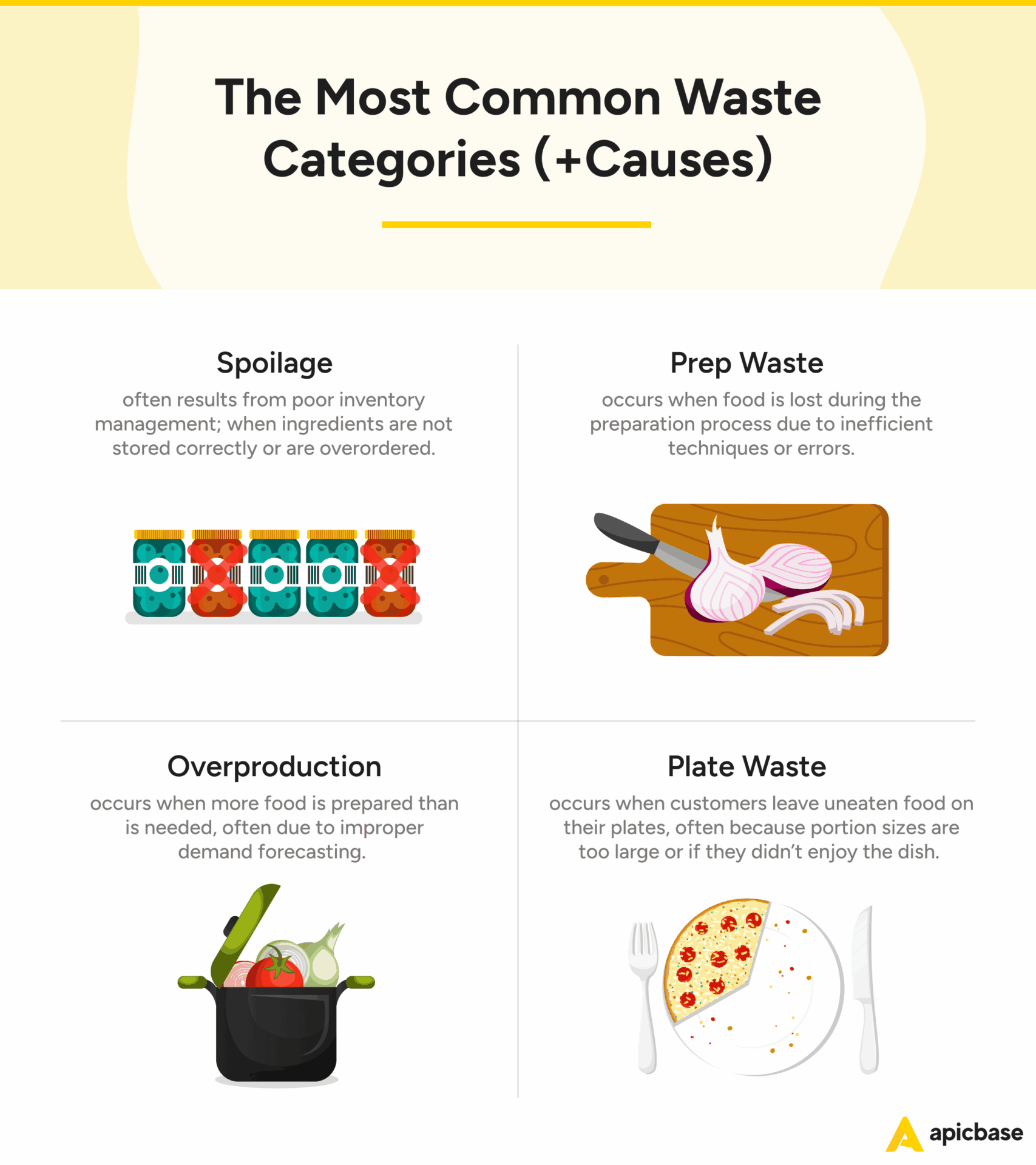
Here are the most common waste categories and their likely causes.
Spoilage = Poor Inventory Management
Spoilage often results from poor inventory management practices. When ingredients are not stored correctly or are ordered in excessive quantities, they are more likely to spoil before they can be used.
Dedicated restaurant inventory management software tracks stock levels, automates ordering, and ensures that ingredients are used up and rotated properly. This reduces the likelihood of spoilage and minimises waste.
Prep waste = inefficient preparation techniques
Prep waste occurs when food is lost during the preparation process due to inefficient techniques or errors. This can include trimming too much from vegetables, overcooking, or poor butchery skills.
By identifying prep waste through a waste log, restaurants can see where they need to retrain staff on proper preparation methods, standardise cutting techniques, and implement better kitchen practices in general. These improvements can significantly reduce prep waste and improve overall kitchen efficiency.
Overproduction = improper demand forecasting
Overproduction occurs when more food is prepared than is needed, often due to improper demand forecasting. This excess food cannot be sold and must be discarded.
Accurate demand forecasting tools can help predict customer demand more precisely, ensuring the right amount of food is prepared. Apicbase’s demand forecasting software uses historical sales data and inventory usage trends to provide accurate forecasts, reducing overproduction and waste.
Plate waste = too large portions or poor menu planning
Plate waste occurs when customers leave uneaten food on their plates, often because portion sizes are too large or if they didn’t enjoy the dish.
By analysing what is most often left on plates, restaurants can adjust portion sizes to better match customer preferences and reduce leftovers.
Effective menu planning can ensure that menu items are designed to satisfy customers and minimise waste from food preparation, by using ingredients more efficiently and better appealing to customer tastes. Apicbase’s menu planning tools help you design menus that produce less waste and boost customer satisfaction.
Implement regular staff training and engagement
Regular staff training and engagement are crucial components of effective waste management and operational efficiency in restaurants. Ongoing training ensures that all team members are equipped with the necessary skills and knowledge to handle food responsibly, minimise waste during preparation and service, and adhere to best practices in inventory management.
Automate tracking and forecasting
Automated tools provide food waste insights and help you make better decisions. They help restaurant operators track stock levels, analyse usage patterns, and generate detailed variance reports faster and more accurately.
Effective restaurant automation empowers restaurant managers to make proactive decisions, such as adjusting orders based on current demand trends or seasonal fluctuations.
Digital waste logs provide significant advantages over traditional paper logs. They ensure accuracy and reliability by reducing human error in data entry and calculation, offering real-time updates and visibility into waste levels.
In general, digital transformation streamlines operations, enhances efficiency, and promotes sustainable practices compared to pen-and-paper practices.
Integrate waste logs with other systems
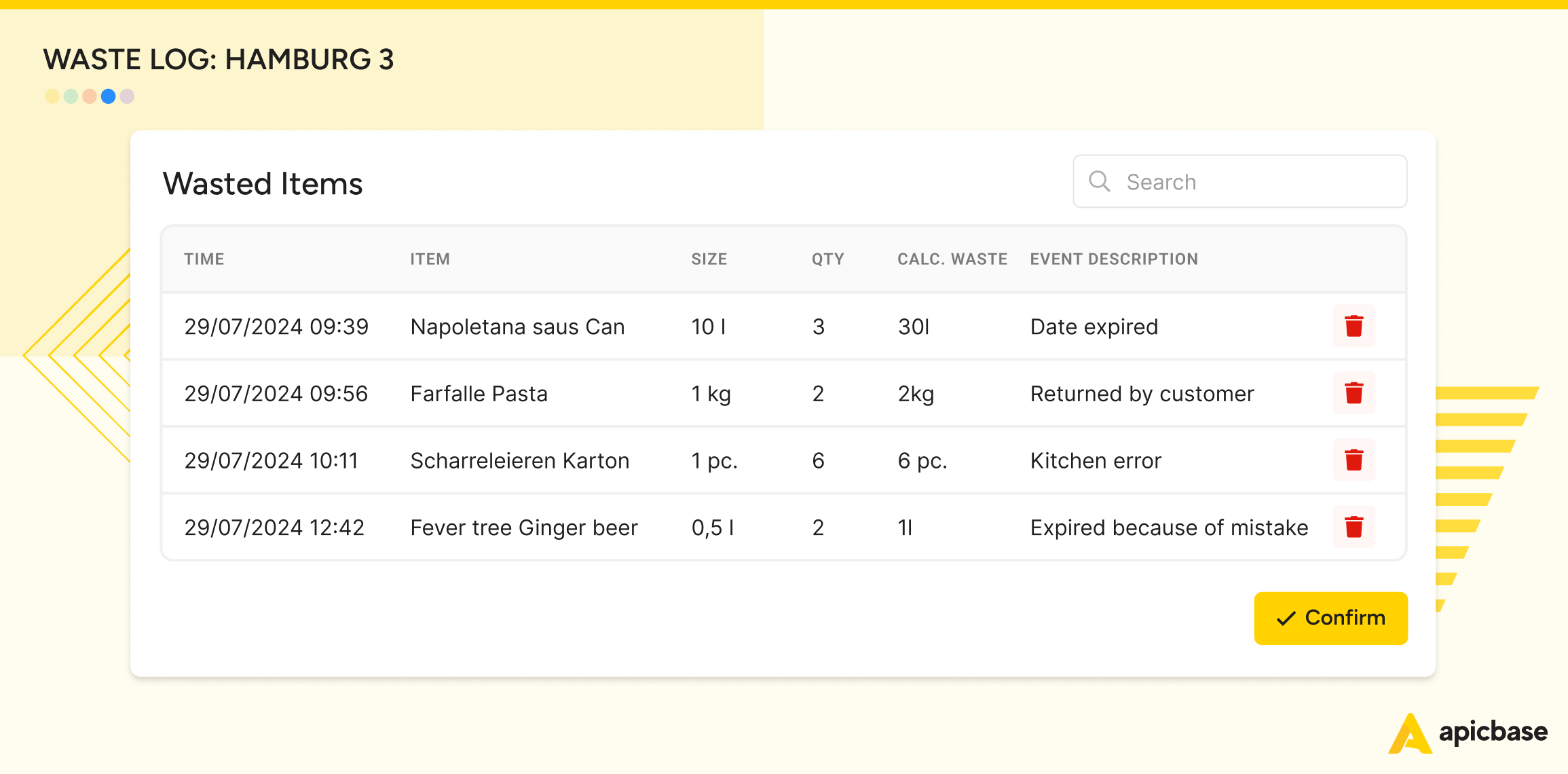
Integrating waste logs with other restaurant management systems enhances operational efficiency and ensures better data use. Restaurant software integrations allow waste data to seamlessly interact with inventory management, menu planning, and your POS system, creating a unified platform. This holistic approach provides a complete overview of how waste impacts various aspects of the business, from procurement to menu design.
For companies with mandatory traceability requirements, integrating waste logs can be particularly beneficial. Apicbase’s robust integration capabilities simplify the process of ‘closing the loop’ on food traceability by ensuring that waste data is accurately reported and updated across all relevant departments.
Regularly review and update waste management strategies
Reducing waste is hard enough, but maintaining that reduction over time is another challenge. Periodic reviews and adjustments to your waste management strategies are essential if you are to sustain your efforts to reduce food waste.
By consistently reviewing waste logs and operational data, you can pinpoint areas where waste reduction efforts may be falling short and make informed adjustments.
This helps you refine procurement practices, improve inventory management, and optimise menu planning.
Master your restaurant waste log with Apicbase
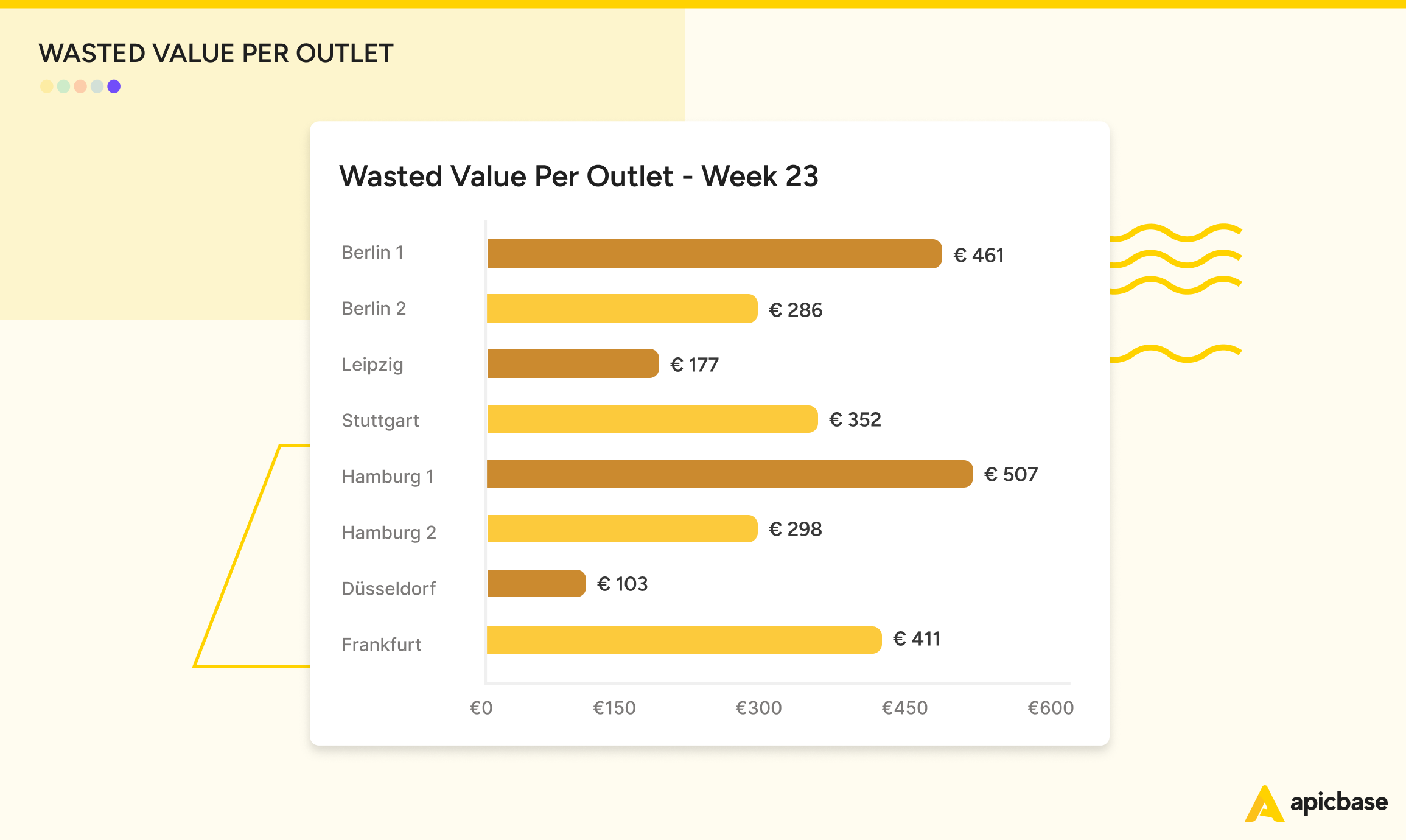
There’s a huge opportunity for restaurants to cut costs, boost profits, and help the environment by reducing food waste. But this is no easy task, especially for multi-site restaurant chains and food service businesses with complex operational needs.
Digital waste logs are essential in reducing food waste sustainably. They provide crucial insights into food waste patterns and inform effective waste reduction strategies.
Apicbase makes logging waste easy and error-free and helps you reduce waste based on the data you collect. It ensures that your restaurants have the right amount of food on hand, minimising the risk of spoilage or waste. Major restaurant and food service operations worldwide use Apicbase’s inventory and recipe data tools to manage their resources and improve profitability.
By reducing waste, you will not only save money on food costs but also demonstrate your commitment to sustainability and social responsibility to your customers: a win-win opportunity for your business and the environment.
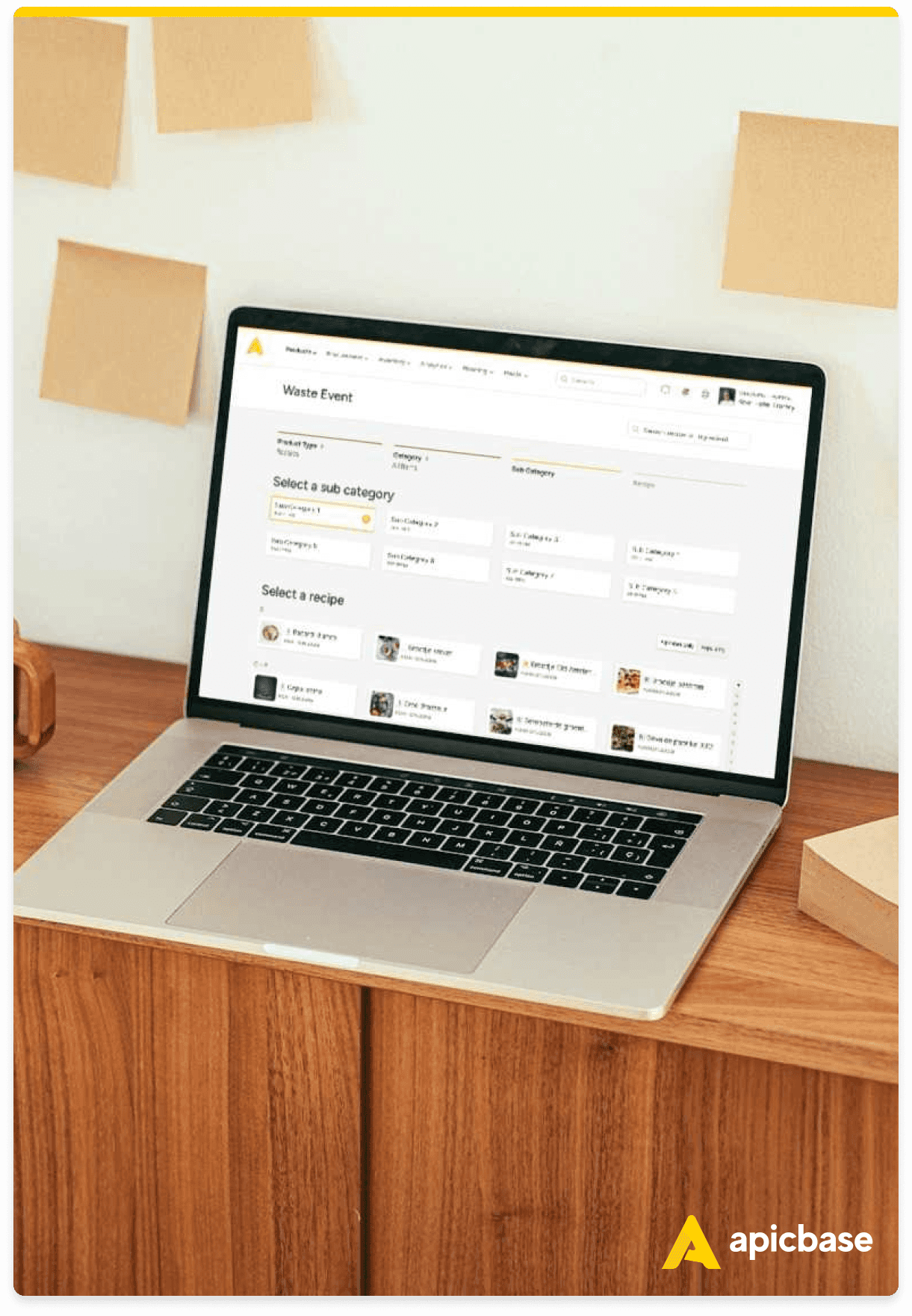
Take control of food waste with Apicbase.
Schedule a demo to see how you can drive down costs today.

